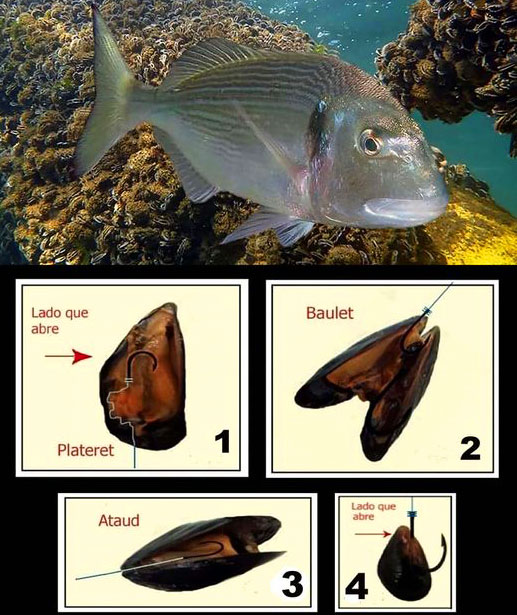4 Ways to Hook Hard baits on the Hook
For fishing to be successful, you need to choose a natural fish live bait, be able to put it firmly on the hook, and inconspicuously hide inside its fishing hooks. It is important that when throwing the bait remains on the hook and has a natural look and smell, as in nature. Buy only quality bait or fish it yourself in a natural live environment. Here we publish specific tips on different ways to hook mussels.
Four basic ways to attach the bait:
1-Plateret, open the mussel and use a small knife to guide the entire mollusk through the bottom shell, we discard the empty shell, and sew the hook into the bottom mollusk along its nerves from the bottom to top, with that present some glaze. I use a #4 hook, the fish scratches the moll and slips inside on its own, it always comes out stuck in the nose. This is a suitable presentation for fishing with a buoy at the tip of the rod, the bait settles to the bottom and the buoy stays submerged an inch, but you see when it sticks and drags it, it is also used in the bottom lead fishing type, as it happens with the “a la blur” joint, but in this modality, which requires short casts, it is easy to take off.
2-Baulet, to open the mussel without separating the shells too much, I put a hook, in the upper nerve that connects the nerves of the two shells, passing it from one side to the other. I also use a small hook for this presentation, #2, sea bream sticking its nose in, and when the mollah is pulled, it sticks out on its own and comes out with a nail out of its nose, this presentation has given me very good results, in particular.
3-Ataud, open the mussel a little and insert a snap with two hooks, in this case, number 2, then close it with lycra, leaving the first hook without death and a little moly to make it smell, this presentation is designed to catch large sea bream, crush it and release the hooks.
4-Criansó (raised mussels), introduce the hook in this case number 2 on the opposite side from the one that opens, and take it out on the same side, leaving the death outside, this hooking method, which costs something to introduce the death, allows you to cast it a long-distance without opening, I usually use a two-hook rigging, with two Criansó, one on each hook, the sea bream medium-size places them both in the mouth.

- Choose a sharp hook. This will make it easier to penetrate the tough shell of the mussel and also increase your chances of a successful catch.
- Use just enough bait. Too much bait will not only increase the chance that your quarry will slip away before you can set the hook but it can also lead to lost or fouled hooks further down the line as other fish compete for the bait.
- Set the hook quickly and firmly. This will help to ensure that the mussel is securely hooked and also increase your chances of a successful release.
Once you’ve got your gear ready, find a spot that’s rich in mussels and start wading in – be careful not to step on any! Once you’ve found a good spot, use your pole to gently thrust the hook into the substrate (the muddy bottom where mussels live) and then pull it towards you. You should feel resistance if you’ve hooked a mussel – if not, try again. Once you’ve got a mussel on your hook, carefully reel it in and enjoy your catch!
1. Use a sharp instrument to make a small hole in the bottom shell of the mussel.
2. Place the pointed end of the instrument into the soft flesh of the mussel, close to the opening at one end.
3. Gently twisting the instrument, work it in between the two shells until you feel some resistance.
4. Continue twisting and pushing until approximately three-quarters of the way into the mussel. If done correctly, you should now have a good grip on the mussel and can pull it from its shell without too much difficulty.
5. Repeat this process for each mussel you wish to catch.
Once you’ve hooked the mussel, you need to make sure it’s secure before casting it back into the water. One way to do this is to hold onto the line and pull on it until you feel resistance from the mussel. If you’re using a bobber or float, you can also wait until it reaches the surface of the water before reeling in your catch.
To prepare them, use a brush to scrub the mussels clean under cold running water. Discard any that are open and do not close when tapped. In a large pot or Dutch oven, heat 2 tablespoons of olive oil over medium-high heat until hot. Add the mussels and sauté for 3 to 4 minutes, stirring occasionally, until they start to turn opaque.
Add the garlic and sauté for an additional minute. Add the white wine and bring to a boil. Cover the pot with a lid and steam for 3 to 4 minutes, until all of the mussels have opened. Discard any that do not open.
Remove the pot from the heat and add butter, parsley, and lemon juice. Season with salt and pepper to taste. Serve immediately with crusty bread for dipping.
Please login or Register to submit your answer
